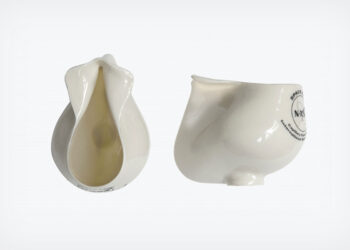
In October 2022, two menstrual cups soared over Portugal on a rocket named Baltasar. Encased in a compact steel capsule, the silicone devices weathered a blistering nine-minute journey through the sky, enduring forces 16 times Earth’s gravity, plunging temperatures, and falling pressure, before returning, undamaged and leak-free. For the scientists behind the AstroCup experiment, it was more than a successful trial.
It was, as one of them put it, the launch of a conversation.
“We really wanted not only to launch the cup,” said Lígia Fonseca Coelho, an astrobiologist at Cornell University and lead author of the new study, “but to launch this conversation.”
The conversation she means is about menstruation in space. It’s a topic that has long hovered in the background of human spaceflight, often ignored, sometimes joked about, and rarely studied with the seriousness it deserves. But as space agencies prepare to send astronauts (many of them women) on years-long missions to the Moon and eventually Mars, the AstroCup team believes the time has come to take this biological reality seriously.
And they’re not alone.
Why menstrual health matters in space

The history of managing menstruation in space has certainly been challenging and, at times, both comical and crude. When Sally Ride became the first American woman in space in 1983, NASA famously asked if 100 tampons would suffice for a week-long trip. I mean, the mission planners could have at least asked their wives, but whatever.
Since then, most female astronauts have used hormonal contraception to suppress their menstrual cycles entirely during missions. The logic is practical: fewer hygiene needs, no bleeding in microgravity, and reduced waste. But what makes sense for a six-month stay on the International Space Station may not hold up for missions that stretch into years.
“If you say to a woman, ‘you have to put your reproductive system on hold for five years and this is the only way you can go to Mars,’ we are going to have problems,” said Coelho.
Indeed, hormonal suppression isn’t always medically advisable, especially for the long haul. It carries known risks, including blood clots and reduced bone density. Such concerns are magnified in the bone-thinning environment of microgravity. And as NASA’s 2023 Decadal Survey highlights, the effects of such long-term treatments in space remain largely unstudied.
That leaves astronauts with few good options. Disposable products like pads and tampons are bulky, generate waste, and must be packed in and packed out; no small matter when every pound of cargo costs thousands of dollars. Menstrual cups, which are small, reusable, and generate no waste, could be the best solution.
However, they were never tested in spaceflight conditions until very recently. Now, researchers are ready to publish their results, which for now have been reported in the preprint server arXiv.
The AstroCup experiment

The 4U PocketSat payload (a steel box just 10 centimeters across) launched aboard a rocket as part of the European Rocketry Challenge housed both the cups and a suite of sensors tracking temperature, humidity, pressure, and acceleration throughout the flight.
At liftoff, the rocket roared off the Portuguese coast and ascended to over 3 kilometers in altitude. It passed through extreme acceleration phases — especially during motor burn, parachute deployment, and landing — with internal sensors measuring forces greater than 16 g. Temperatures hovered between 32 and 34 degrees Celsius. Humidity dropped to 40%. Atmospheric pressure fell below 70,000 Pascals.
After 9.3 minutes in the air, the rocket returned to Earth. The cups were retrieved, inspected, and tested again.
There was not a single leak. No signs of damage. Both cups functioned exactly as they had before the launch.
“Now we know that cups made by Lunette, and probably other brands, are very resilient in the turbulence and microgravity of a rocket launch,” said Coelho.
To simulate menstrual fluid, the team used glycerol, a thick liquid similar in consistency to blood. In both pre-flight and post-flight tests, the cups held the fluid without leaking or degrading. Control cups kept on the ground performed similarly.
It was a modest test in terms of altitude and duration. But it was a major first step.
From suborbital rockets to Mars
The AstroCup experiment marks the first documented test of menstrual cups under spaceflight conditions. But it didn’t actually leave the atmosphere or experience microgravity for long. That’s why the team sees this as just the beginning.
“This was just the proof of concept,” said Coelho. “Next, we want to see how they perform over time — over weeks or months — perhaps aboard the International Space Station.”
The Moon and Mars, each with their own gravitational quirks — one-sixth Earth’s gravity on the Moon, one-third on Mars — could affect how menstrual cups behave, especially during insertion, removal, or cleaning. In microgravity, fluid doesn’t flow the way it does on Earth. That could complicate the mechanics of use and cleaning.
Another concern: hygiene. Astronauts can’t just run hot water over the cups as they would on Earth. Cleaning protocols would need to be developed to ensure safety across multiple menstrual cycles, and any reusable product must hold up under conditions of limited water, long durations, and radiation.
The AstroCup team is already in discussions to place menstrual cups aboard the ISS for longer-term studies. They also hope to test how radiation, temperature extremes, and vacuum exposure affect the materials over time.
“In space, we are mainly dependent on what we bring from Earth,” Coelho said. “It’s in these little things where we see gaps still existing in the technology of medical devices.”
A shift in space medicine
While the AstroCup mission is small, its implications are far-reaching. As space exploration becomes more inclusive, medical technologies must evolve to reflect the full spectrum of human biology.
Until recently, most life-support systems and medical protocols in space were designed around male astronauts. That includes how urine is processed, how clothes are washed (they’re not actually; astronauts literally wear their clothes until they’re too dirty to bear, then they’re released into the atmosphere for destruction), and how medical emergencies are managed. Menstruation has long been sidelined.
But the numbers are changing. More than 100 women have flown to space since Valentina Tereshkova’s first solo mission in 1963. As of 2025, women represent over 15% of all astronauts. With NASA’s Artemis program aiming to send the first woman to the Moon by 2026, and with multi-year Mars missions on the horizon, menstruation in space is no longer an edge case.
In fact, as the study points out, an astronaut involved in the Artemis program from 2025 to 2035 might face up to 20 years of menstrual suppression.
What comes next?
The AstroCup project doesn’t claim to offer the final answer. Rather, it opens the door to a broader dialogue about choice, equity, and health care in space.
“It’s already going to be uncomfortable to not have air to breathe, to not have water from a natural source to drink,” Coelho said. “Let’s make them as comfortable as possible so they can have their normal human processes happen in a positive way, so they can focus on finding life on Mars, on building the colony, on putting us in the next frontier.”






